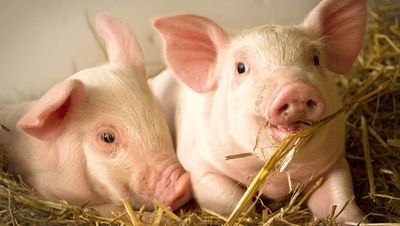Growing Human Organs Inside Pigs Could Save Lives, But the U.S. Won't Fund the Research
The shortage of organs is a public health menace. Approximately 120,000 people in the U.S. need a lifesaving organ transplant. Of those, approximately 75,000 patients are on the active waiting list. Every day, nearly 20 individuals die from the shortage of organs in the United States.
Ethical concerns about human-animal chimera research might be dramatically overblown.
Scientists worldwide are developing new methods with potential to save countless patients in need of organs. Such approaches have tremendous potential, if only ethical and regulatory challenges could be overcome first.
One way that scientists are proposing to increase the number of transplantable organs is to produce organs from patient stem cells.Owed to their ability to grow limitlessly in the lab and form all tissue types, pluripotent stem cells from patients, in principle, could supply an infinite amount of cells that could potentially be transplanted back into patients. Unfortunately, all efforts to generate organs that can be transplanted into patients from stem cells to date have been unsuccessful.
A different encouraging approach is to generate patient organs inside livestock species, such as pigs. In the latest methods, interspecies chimeras – animals containing cells from both humans and animals – are generated by introducing human stem cells into early-stage animal embryos. Key genes essential for organ formation are disabled, allowing the introduced human stem cells to fill the empty space. In theory, this strategy will produce a human organ inside pigs or sheep.
Creating chimeras is not new in biology. Chimeras, or animals comprised of tissues from two different individuals, have already been deployed in research. Mouse chimeras are routinely used to create genetically engineered mice to study genes. The concept of generating human organs inside pigs or sheep comes from previous studies involving interspecies chimeras generated between mice and rats. Past experiments have demonstrated that it is possible to generate a rat pancreas inside a mouse.
Scientific and Ethical Obstacles
Unfortunately, chimera research has faced hurdles that have impeded progress. Of note, attempts to generate interspecies chimeras by several groups have failed. The results of these studies indicate that human cells appear unable to grow inside mouse embryos. The levels of human chimerism – the number of human cells inside the host animal embryo – appear too low to support any human organ generation.
Another obstacle is that chimera generation is ethically controversial. Some question the moral status of an animal that is comprised of human and animal cells. The most concerning question is whether human cells will contribute to the host animal's brain, potentially altering the cognition of the animal. These issues have prompted scientists to proceed very cautiously with chimera experiments. However, such concerns might be dramatically overblown. This is because the levels of human chimerism are too low to cause any significant change in animal brain function.
The ethical controversy has affected research policy in the United States. In the United States, the National Institutes of Health (NIH), the major funding body of biomedical research, blocked funding for chimera research while ethical questions were considered. Later, it was proposed that a new review process would be instated for chimera research. However, no change in policy has actually happened. The restrictive NIH policy is a major barrier to chimera research progress because laboratories around the United States cannot obtain funding for it. Lifting the restrictions on NIH funding for chimera research would dramatically accelerate chimera research.
Nonetheless, despite the past and current hurdles that chimera research has faced, new advances are changing the landscape of chimera research.
It is time to lift restrictions on chimera research so that its promise can be fully realized.
Progress on the Horizon
Scientists are developing improved strategies to increase the numbers of cells in animal embryos to the point where it might be possible to generate a human organ in an animal. For example, it has been suggested that the human stem cells researchers have been using cannot grow in animals. Scientists have made advances in generating new types of human stem cells that might have an improved ability to form chimeras.
Additionally, scientists have identified some barriers responsible for the failure to generate chimeras. For example, preventing cell death and enhancing the ability of stem cells to compete with host animal tissues also improves the numbers of human cells to the point where human organs can be generated inside an animal.
Finally, a relaxation of regulatory hurdles in other countries has created a more permissive environment for human-animal interspecies chimera research. In March, the Japanese government approved the first such experiments that could comprise a new way of generating organs from patients for transplantation.
Additionally, in spite of the somewhat negative attention that chimera generation has received, the International Society for Stem Cell Research (ISSCR) supports the new Japanese policies allowing chimera experiments. The ISSCR maintains that research involving the generation of chimeras should be permitted, as long as rigorous oversight and ethics review occur.
Chimera research has the potential to transform medicine. Of all the impediments, the NIH restrictions on funding remain the single most significant barrier. It is time to lift restrictions on chimera research so that its promise can be fully realized. One day, it might be possible to grow patient-specific organs inside of livestock animals such as pigs and sheep, saving thousands of human lives. But to change our current policy, the public, scientists, and bioethicists must first agree that this critical cause is worth fighting for.
